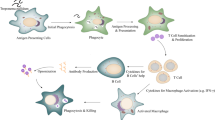Abstract
Groups of mice were neonatally thymectomized and treated with antithymocyte serum (ATS) prior to challenge infection with viable yeast phase (YP)Histoplasma capsulatum G-17M. Moderate leucocytosis and moderate lymphopenia were seen in immunodeficient animals after infection. Surviving immunodeficient mice exhibited low levels of migration, inhibition activity, while peritoneal exudate cells and spleen cells harvested from surviving infected and untreated normal mice showed significant migration inhibition in the presence of histoplasmin antigen.
The LD50 values for YP cells ofH. capsulatum were 1.1×106 for normal untreated mice, 6.0×105 for thymectomized mice, and 6.3×105 for ATS-treated mice. Thymectomized mice that also received ATS treatment exhibited an LD50 of 1.7×105 and were 6.5 times more susceptible to infection then normal mice. Mice which were either thymectomized or treated with ATS were 1.7 times as susceptible as normal mice to infection withH. capsulatum. The criterion of susceptibility is a decrease in the LD50 value.
Similar content being viewed by others
References
Adamson, D. M. & Cozad, G. C., 1969. Effect of antilymphocyte serum on animals experimentally infected with Histoplasma capsulatum or Cryptococcus neoformans. J. Bacteriol. 100, 1271–1276.
Anderson, K. L. & Marcus, S., 1969. Variability in virulence of strains of Histoplasma capsulatum. Amer. Rev. Resp. Dis. 99, 608–609.
Anderson, K. L., Wheat, R. W., Conant, N. F. & Clingenpeel, W., 1974. Composition of the cell wall and other fractions of the autolyzed yeast form of Histoplasma capsulatum. Mycopath. Mycol. Appl. 36, 179–187.
Amos, D. B. & Peacocke, N., 1963. Leucoagglutination. A modified technique and preliminary results of absorption with tissues. Proc. IX Cong. Europ. Soc. Haematol., Lisbon, P. 1132, S. Karger A.G., Basel.
Bennett, B. & Bloom, B. R., 1968. Reactions in vivo and in vitro produced by a soluble substance associate with delayed-type-hypersensifivity. Proc. Nat. Acad. Sci., U.S.A. 59, 756–762.
David, J. R., 1968. Macrophage migration. Fed. Proc. 27, 6–12.
Einhorn, N. H. & Rountree, L. G., 1936. The biologic effects of thymectomy. Endocrin. 20, 342–347.
George, J. & Vaughan, J. H., 1962. In vitro cell migration as a model for delayed hypersensitivity. Proc. Soc. Exp. Biol. Med. 111, 514–522.
Gray, J. G., Monaco, A. P., Wood, M. L. & Russel, P. S., 1966. Studies on heterologous anti-lymphocyte serum in mice. I. In vitro and in vivo properties. J. Immunol. 96, 213–228.
Heiner, D. C., 1958. Diagnosis of histoplasmosis using precipition reactions to agar-gel. Pediatrics 22, 616–627.
Hill, G. A. & Marcus, S., 1960. Study of cellular mechanisms in resistance to systemic Histoplasma capsulatum. J. Immunol. 85, 6–13.
Howard, D. H., 1965. Intracellular growth of Histoplasma capsulatum. J. Bacteriol. 89, 518–523.
Howard, D. H., Otto, V. & Gupta, K., 1971. Lymphocyte mediated cellular immunity in histoplasmosis. Infect Immunity. 4, 605–610.
Kaufman, L. & Blumer, S., 1966. Occurence of serotypes among Histoplasma capsulatum strains. J. Bacteriol. 91, 1434–1439.
MacKaness, G. B., 1964. The behavior of Microbial parasites in relation to phagocytic cells in vitro and in vivo. Gen. Microbiol. 14, 213–239.
Miller, L. C. & Tainter, M. L., 1944. Estimation of the ED50 and its error by means of logarithmic-probit graph paper. Proc. Soc. Exp. Biol. Med. 57, 261–264.
Salvin, S. B. & Cheng, S. L., 1971. Lymphoid cells in delayed hypersensitivity, II. In vitro phagocytosis and cellular immunity. Infect. Immunity. 3, 548–552.
Salvin, S. B. & Furcolow, M. L., 1954. Precipitins in human Histoplasmosis. J. Lab. Clin. Med. 43, 259–274.
Sjodin, L., Dalmasso, A. P., Smith, J. M. & Martinez, C., 1963. Thymectomy in newborn and adult mice. Transplantation 1, 521–525.
Wu, W. G. & Marcus, S., 1963. Humoral factors in cellular resistance I. The effects of heated and unheated homologous and heterologous sera on phagocytosis and cytopesis by normal and immune macrophages. J. Immunol. 91, 313–322.
Author information
Authors and Affiliations
Rights and permissions
About this article
Cite this article
Anderson, K.L., Ross, W.D. Susceptibility of immunodeficient mice to challenge infection with histoplasma capsulatum. Mycopathologia 73, 73–78 (1981). https://doi.org/10.1007/BF00562593
Issue Date:
DOI: https://doi.org/10.1007/BF00562593




